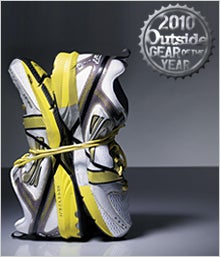Because of the repetitive pounding of road running, you need a shoe designed for your particular foot strike. (Consult a specialty running store to diagnose your type.) If you overpronate, with your foot and ankle tending to roll inward, you need a “light stability” or “stability” shoe to help steady your foot and avoid injuries. Those used to be beefy and stiff, but now there are a lot more lightweight, speed-oriented offerings in the category. If you don’t pronate, look for a neutral shoe—which will give you extra cushioning—and the choices will generally be lighter. Remember, your body weight and pace matter. If you’re a Thoroughbred, stick to more flexible, lighter-weight shoes. Clydesdale? Look for thick cushioning or hefty stability. And unless you’re buying clearance, plan to pay at least $85; less than that and you’re most likely sacrificing performance and durability. When to retire them? If wrinkles start showing up on the side of the foam or if a new injury creeps up—and definitely after 350 or 400 miles.
Our winner this year is Scott’s Makani II. When we heard Scott, a company better known for ski gear and carbon-fiber bikes, was bringing a line of performance running shoes to the U.S., we were skeptical. Then we tried them. The Makani II was simply the most speed-inspiring and enjoyable shoe in our test. Most shoes this light feel like flimsy racing flats, not trainers. But the Makani has a carbon plate embedded in the midsole that creates structure without bulk, delivering support for low-grade overpronators and fatiguing long runs. “I ran ten miles fast,” said one tester, “and my legs weren’t tired like they’d be in other shoes.” Comfortable? That’s an understatement. The two- piece, socklike upper teams up with a supportive heel cradle for a secure and agile-feeling fit, and the midsole cushioning, though softer in the forefoot than most, felt perfectly balanced—cushy but not squishy, not too flexy but not too firm.
10.1 oz;
Stability: 3.5 (out of 5)
Softness: 3.7
Speed: 5


